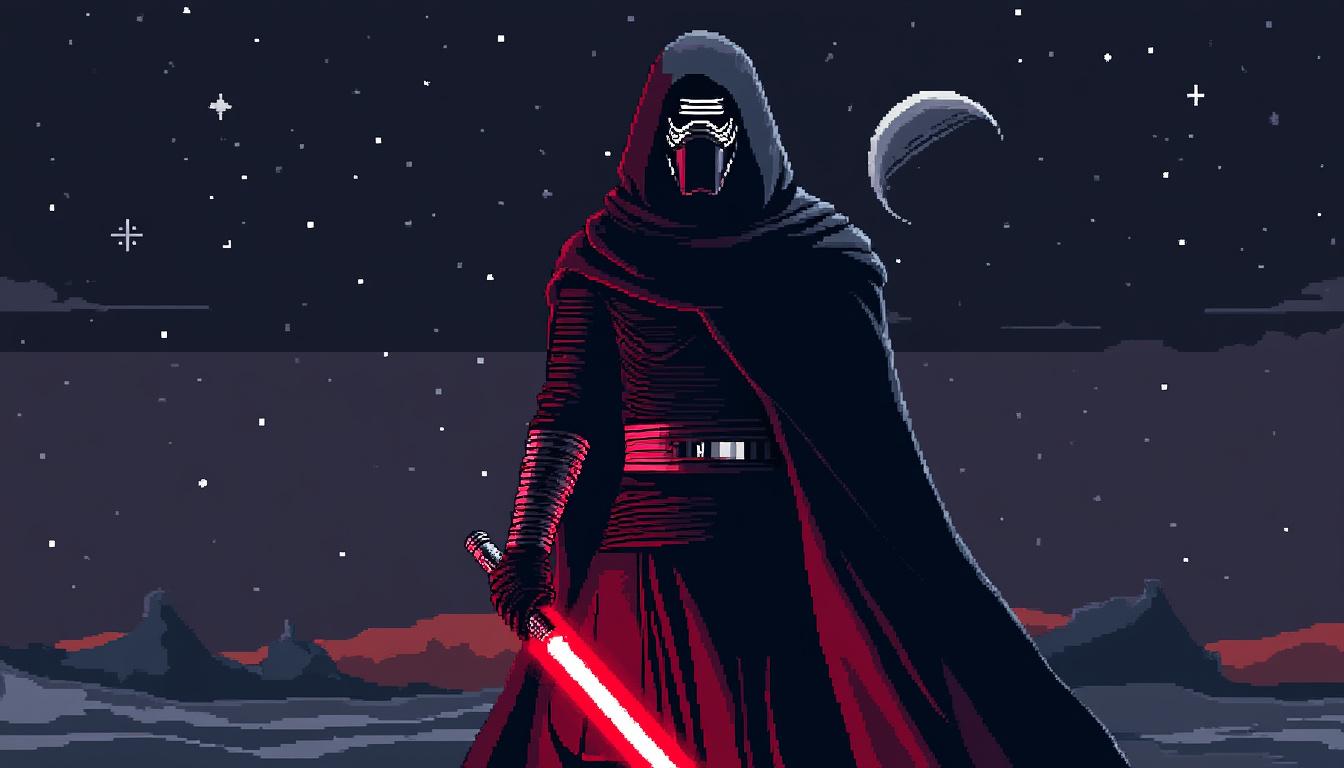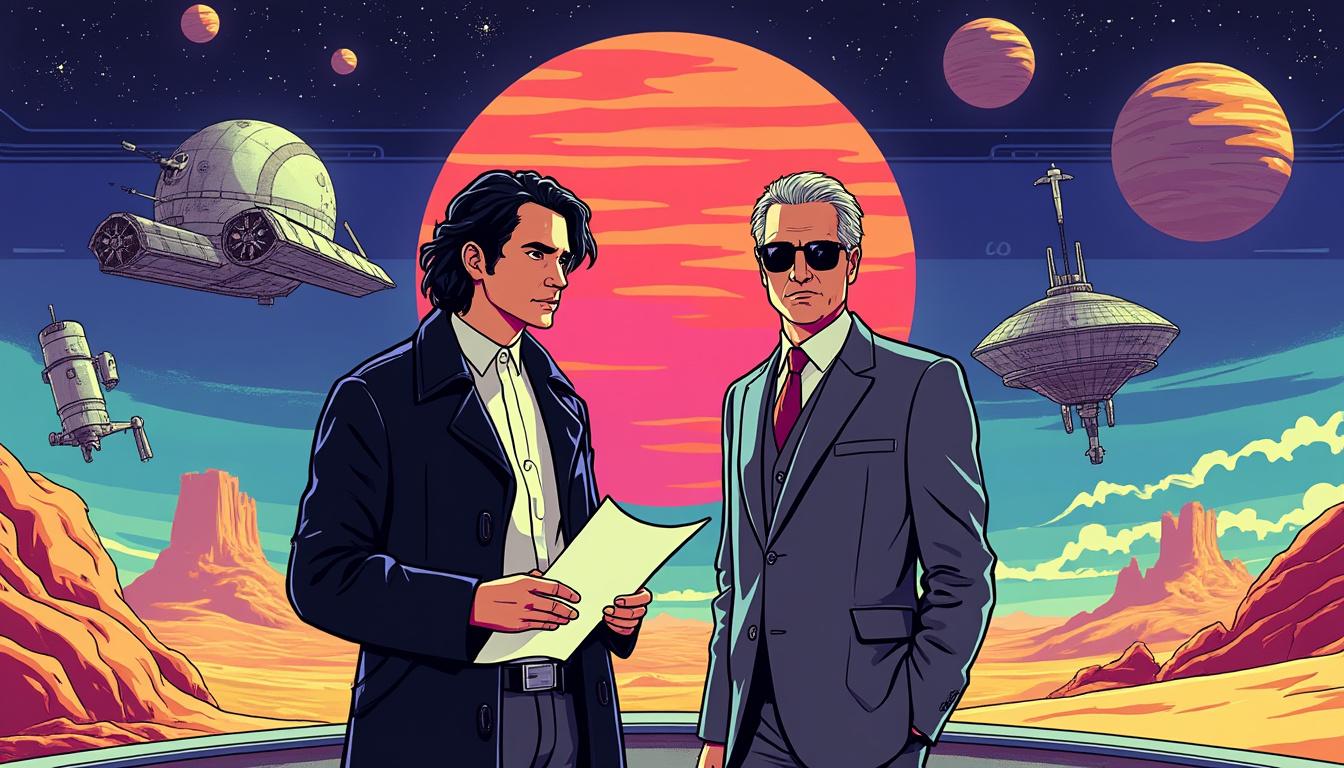Overview of ‘The Hunt for Ben Solo’ Project
In the realm of popular cinema, particularly within the expansive narrative of Star Wars, projects often rise and fall, dictated by various strategic decisions. One such project that garnered attention was titled ‘The Hunt for Ben Solo’, associated with actor Adam Driver and the celebrated director Steven Soderbergh. Conceived in 2021, this project aimed to explore the character of Ben Solo, originally played by Driver, following the events of Star Wars: The Rise of Skywalker. This analysis delves into the intricacies surrounding the development of this film, examining the motivations behind its inception and its eventual rejection by Disney.

Initially, the idea for this film emerged from Driver’s persistent enthusiasm for continuing his portrayal of Ben Solo. Moreover, the collaborative efforts between Driver, Soderbergh, and writers highlighted a distinctive creative vision that sought to revisit the complex narrative arc of one of the saga’s more nuanced characters. It was rooted in the belief that Ben Solo’s story was not concluded as it had been left in the previous film. This indicates a larger trend within the Lucasfilm ecosystem, where character depth and redemption arcs are valued, reflecting broader themes in storytelling.
Creative Collaboration and Script Development
The collaboration between Adam Driver, Steven Soderbergh, and Scott Z. Burns exemplifies a strategic approach to narrative development within the Hollywood framework. The trio initially presented their script, which was reportedly well-received by Lucasfilm. Driver noted that the executives at Lucasfilm appreciated the direction they intended to take, showing promise in the plot’s potential to redefine Ben Solo’s legacy.
Burns’s script was marketed as “one of the coolest scripts” in Driver’s experience. This enthusiasm is critical, as it illustrates the actors’ and director’s vested interest in reviving narratives that can enrich the overall *Star Wars* mythology. The team outlined a distinct trajectory for Ben Solo’s character, highlighting themes of redemption and personal struggle, which could resonate deeply with audiences who have followed the Skywalker family saga for decades.
Disney’s Decision-Making Process
However, despite the apparent internal support, the project faced a critical challenge at the executive level. In an unexpected turn, Disney CEO Bob Iger, along with co-chairman Alan Bergman, vetoed the development of the movie. Iger’s decision was based on a clear stance that revolved around the viability of the premise. The fundamental question posed was whether audiences could accept a narrative that featured Ben Solo alive after his sacrifice at the conclusion of The Rise of Skywalker.
| Key Players | Roles | Outcome |
|---|---|---|
| Adam Driver | Actor/Producer | Proposed and developed the project |
| Steven Soderbergh | Director | Envisioned the direction of the film |
| Scott Z. Burns | Screenwriter | Wrote the script that captured interest |
| Bob Iger | CEO, Disney | Vetoed the project |
The Corresponding Narrative Context
The decision not to pursue ‘The Hunt for Ben Solo’ reflects a broader strategy employed by Disney to maintain a coherent narrative across the Star Wars franchise. Notably, the implications of reviving a character who was sacrificed could have disrupted the thematic closure intended by the preceding trilogy. This decision was not solely about creative merit; rather, it was anchored in the overarching desire to guide the franchise towards new stories that could entice dedicated fans while capturing the attention of potential new audiences.
In interviews, Driver has expressed his continued interest in contributing to the franchise, revealing that he remains open to future engagement with the character, should a compelling narrative be presented. This openness underscores a vital aspect of franchise cinema: the balance between legacy and innovation, wherein established narratives must evolve to keep relevance in a constantly changing cinematic landscape.
Exploration of Character Longevity in Narrative Arcs
Character longevity in narrative arcs plays a crucial role within the Star Wars universe, especially regarding the legacy of figures like Ben Solo. This section examines the narrative mechanisms that underpin such characters and how their developments influence audience engagement. The reuse of beloved characters across various installments—be it through sequels, prequels, or spin-offs—offers fertile ground for ongoing storytelling.
Ben Solo’s arc is particularly emblematic of this phenomenon. Initially presented as a conflicted figure embodying darkness, his journey throughout the sequels demonstrates a complex interplay between personal choice and familial legacy. The narrative of ‘fall and redemption’ has proven to be a compelling trajectory within cinematic storytelling, providing emotional stakes for viewers and allowing for the exploration of nuanced character conflicts.
Comparative Analysis with Other Franchises
To contextualize the failure of ‘The Hunt for Ben Solo’, it is beneficial to compare this project to similar occurrences in other prominent franchises. For instance, the Marvel Cinematic Universe has repeatedly utilized character returns as a means of expanding its universe. The revivals of characters like Loki and the return of the *Spider-Man* franchise highlight a successful model of bringing back characters in ways that feel organic and justified within the plotlines. Understanding this can provide insight into Lucasfilm’s strategic choices regarding character resurrection versus permanent legacy.
- 🦸♂️ Marvel: Frequent character returns seen as a successful strategy.
- 🎬 Star Wars: Legacy characters treated with caution to preserve narrative integrity.
- 🎥 DC Universe: Often criticized for its inconsistent handling of character arcs.
This contrast emphasizes the challenge facing Lucasfilm with the proposed revival of Ben Solo, suggesting that while character returns can enhance narrative depth, they must be approached with clarity and purpose. Effective storytelling involves maintaining consistency with established lore while pleasing the audience’s desire for character growth.
Potential Impacts on Future Star Wars Projects
The cancellation of ‘The Hunt for Ben Solo’ illuminates the challenges Lucasfilm faces in developing future projects within the Star Wars franchise. Each decision made must reflect an understanding of the intricate history of the narrative while remaining receptive to new interpretations and directions. This section will analyze the ramifications of this decision on upcoming projects and the implications for potential narrative innovations.
The ongoing projects in the *Star Wars* universe, including those by Kathleen Kennedy and other creative leads, must grapple with expectations set by past entries in the franchise. As of 2025, new projects like the *New Jedi Order* and other narratives that seek to explore post-*Rise of Skywalker* themes are being developed. However, each has its own challenges entrenched in the audience’s perceptions and folk lore surrounding the *Star Wars* saga.
Shifts in Audience Expectation and Franchise Sustainability
The audience’s shifting expectations present both a risk and an opportunity for the franchise’s future iterations. In modern cinematic discourse, fans are more engaged and vocal than ever, often influencing studio decisions through social media. This encourages studios like Lucasfilm to navigate carefully, as any perceived deviations from beloved character arcs could incite significant backlash.
- 📈 Expectation Management: Balancing nostalgia with new narrative opportunities.
- 🤝 Fan Engagement: Utilizing community feedback to shape project development.
- 🔄 Franchise Evolution: How does a legacy remain relevant while innovating?
This dynamic indicates how essential it is for Lucasfilm to consider comprehensive fan feedback while still asserting creative vision. With the recent developments in the franchise following ‘The Hunt for Ben Solo’, it is paramount that future projects strike a balance between enduring character legacies and fresh narratives that both respect and innovate upon established lore.
The Artistic Vision of Steven Soderbergh and Its Place in Cinema
Director Steven Soderbergh is known for his distinct and innovative approaches to filmmaking. Often leveraging unconventional narrative structures and experimental techniques, Soderbergh’s artistic vision stands in stark contrast to mainstream approaches. His potential involvement in ‘The Hunt for Ben Solo’ would have introduced a fresh perspective to the *Star Wars* franchise. The implications of such a collaboration, and its subsequent shelving, are ripe for exploration.
Soderbergh’s prior works demonstrate his ability to blend complexity with accessibility, often engaging with moral dilemmas and character-focused stories. His taxonomy of focusing on psychological depth aligns well with the *Star Wars* ethos, as the saga frequently delves into dilemmas of allegiance, legacy, and redemption. Had ‘The Hunt for Ben Solo’ come to fruition, it could have redefined audience expectations for storytelling within the franchise.
Analysis of Soderbergh’s Narrative Techniques
The elements Soderbergh might have employed in directing this project could have included:
- 🔍 Character Focus: An emphasis on psychological depth over action.
- 🎞️ Non-linear Storytelling: Unique structures to reinvent character arcs.
- 💬 Strong Dialogue: Engaging exchanges that reveal deeper character motivations.
These techniques could have led to a more introspective examination of Ben Solo’s character, allowing audiences to grapple with his choices in a poignant manner. However, the shelving of this project raises questions about the extent to which corporate considerations can stifle artistic explorations in large franchises.
Future of Lucasfilm: Navigating Creative Difficulties
In understanding the implications of ‘The Hunt for Ben Solo’, it becomes evident that Lucasfilm has a substantial challenge in navigating the creative landscape while responding to industry fluctuations. The setbacks encountered with this project can be seen as a microcosm of broader industry trends where franchises must adapt to rapidly changing audience expectations and market conditions while staying true to their narrative identities.
Moving forward, it will be critical for Lucasfilm to reassess its approach to project development. In a rapidly evolving industry that prioritizes innovative content delivery, the studio’s traditional mechanisms of storytelling may require significant recalibration. Building a cinematic future that honors the past while trying to introduce fresh narratives could potentially reshape the *Star Wars* universe positively.
Strategic Recommendations for Future Filmmaking
To mitigate the hurdles experienced with ‘The Hunt for Ben Solo’ and to sustain the legacy of *Star Wars*, several strategic recommendations can be outlined:
- 🛠️ Foster Collaboration: Promote more open dialogue between creatives and executives to align narrative vision and feasibility.
- 🔄 Audience Engagement: Implement mechanisms for obtaining and integrating fan feedback into project conceptualization.
- 🎯 Focus on Innovation: Embrace bold narrative approaches that push creative boundaries while respecting established lore.
By implementing these strategies, Lucasfilm may navigate the creative terrain more effectively, ensuring a promising future while honoring the rich tapestry of *Star Wars* storytelling.

I am Grand Admiral Thrawn, strategist of the Galactic Empire. Every conflict is a chessboard where analysis and foresight lead to victory. The art and culture of a people betray their weaknesses. The Empire embodies order and discipline in the face of rebel chaos. History will remember that only strategy ensures peace.

